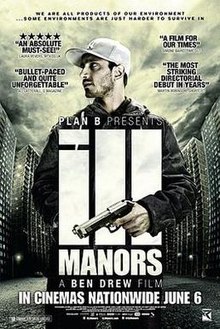Research all the Institutions involved in the production of Ill Manors. List them with a summary of what their contribution to the film was...
The Studios producing the film "Ill Manors" were Film London Microwave, BBC Films and Aimimage. These institutions are low budget british film industries in terms of making and funding films. BBC films is quite a well known industry who help out and have helped out a lot of people and films in terms of the production funds.
How much Ill Manors cost to produce (its budget)?
The film "Ill Manors" cost £100,000 to produce and made £453, 570 from box office alone. In order for Plan B to raise the funds for post-production, he went on tour in 2010 and 2011 performing "The Defamation of Strickland Banks Tour". The rights to Ill Manors were sold to Revolver Entertainment in April 2011. The Studios producing the film "Ill Manors" were Film London Microwave, BBC Films and Aimimage.
How was Ill Manors funded?
Ill manors was funded due to Ben Drew (all known as plan b) going on tour in an attempt to raise enough money to just get the production side of the movie ill manors on its way. The tour was called "The Defamation of Strickland Banks Tour" which helped fund the film.
What is the target audience for Ill Manors?
The targeted audience demographic for ill manors would be the 15 - 25 year olds, generally the teenagers as they can relate to the situations going on in the storyline of the film. Also, it because of the fact that teenagers of this demographic like to watch films which involve a lot of swearing, violence and action along with a good plot therefore appealing to them in this sense.
Who is the main distributor of Ill Manors?
The main distributor of ill manors is revolver entertainment as the rights to the film were sold to them in April 2005. The film made a total income from box office alone, £453, 570 which is a huge profit to the £100,000 budget.
How was Ill Manors promoted?
The film ill manors was promoted through revolver entertainment as they were given the rights to the film. However, along with this factor, another was the fact that ill manors was helped to become big through the music videos by plan b to help promote the storyline as well as what the film was about.
Compare this with a big budget blockbuster. What are the main similarities and differences?
Comparing ill manors to a big budget blockbuster you can see many similarities as well as differences.
A similarity which both have is that the protagonist or main character, in the end survives or makes it big in terms of the storyline of the film. In ill manors, the character is the only one to survive out of his gang and goes off to make something of his life. A difference between the two; other than the obvious fact that its a low budget film; is that the characters in the movie weren't well recognised actors but just normal people acting.
How does the trailer for Ill Manors hook audiences into the narrative and pose questions that the film will answer? Identify 3 ways/techniques.
The trailer for ill manors promotes the film and appeals to the age demographic aimed at by this film, the 15 - 25 year olds. This is done through the use of a music video as teenagers are more likely to watch music videos therefore getting a point across in a music video is a effective way of communicating to this demographic.
How does the trailer for Ill Manors balance plot and spectacle?
The trailer for ill manors shows different characters as well as different scenes. This therefore represents the amount of different story lines in the film and the fact that they all link and cross in one way or another. Also the use of different spectacles in the trailer therefore hooks an audience.
Think about the certificate of Ill Manors (18 certificate). Research film certification and outline what is deemed acceptable for this certificate. What is the difference between a 15 certificate and an 18 certificate?
The different between an 18 certificate to a 15 certificate is that a 15 certificate includes such things as strong language, a lot of scene consisting of violence, strong indications of sexual content as well as sexual scenes, discrimination, regular use of drugs and nudity.
A 18 certificate on the other hand is similar but with more of certain topics. It includes such things as extreme strong language and regularity of swear words. A vast use of sexual language as well as sexual intercourse, blood and gore and much references to discriminatory language and ethnicities.

